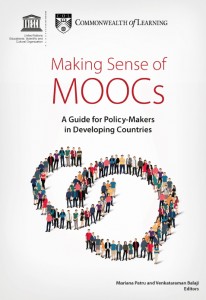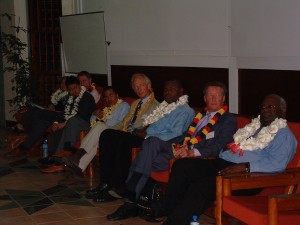If you undertake an internet search for ‘Making sense of MOOCS’, you’ll find two main results. One is to a 2012 paper by Sir John Daniel, and the other is a recent (June, 2016) publication from the Commonwealth of Learning (CoL) and UNESCO.
Daniel’s article was both timely and useful, coming during the height of the hype about MOOCs, with exaggerated claims and fanciful predictions abounding.
His solid and sensible appraisal was widely lauded, with a positive review accompanied by informative comments found on Tony Bates’ website. Stephen Downes, in particular, makes some critical points, pointing out the lack of detail concerning cMOOCs, as opposed to xMOOCs.*
 Now to the Col/UNESCO publication ‘Making Sense of MOOCs: A Guide for Policy-Makers in Developing Countries‘. If you’re wondering why this should be important, let me quote from the Foreword by Dr Qian Tang of UNESCO:
Now to the Col/UNESCO publication ‘Making Sense of MOOCs: A Guide for Policy-Makers in Developing Countries‘. If you’re wondering why this should be important, let me quote from the Foreword by Dr Qian Tang of UNESCO:
The aim of this Guide is to provide a strong case for governments in developing countries to be aware of the huge potential of online learning and MOOCs. Let me highlight a few of the benefits:
First, open and online education is seen as an innovation driver for improving education and as a basis for transforming secondary and higher education systems. In this respect, MOOCs are excellent for promoting lifelong learning. As courses offered free-of-charge to any number of people, anywhere and anytime, MOOCs enable access to higher education and beyond for people who cannot afford a formal education and are disadvantaged. In this respect, MOOCs may be regarded as contributing to the democratisation of higher education.
Second, MOOCs can reduce the disconnect between the skills and aptitudes of the majority of university graduates and the needs of the industry sector in many countries. This disconnect is triggering huge unemployment amongst youths and adults, particularly women.
MOOCs can be useful in providing job-oriented training and skills development, and we are already witnessing a number of policies and initiatives in certain emerging and developing countries strategically leveraging online learning, including MOOCs, for workforce development and upskilling programmes. However, issues related to credentials for MOOCs remain a challenge. This is an area demanding closer, multi-stakeholder collaboration, involving governments, higher education institutions and the private sector.
Third, MOOCs emerged from the open education movement. As such, they enable free access to high-quality content and resources, which might be too costly for higher education institutions in developing countries to produce. Use and reuse of MOOCs is therefore an important consideration in developing a national strategy. However, it is crucial to adapt such resources to various contexts.
Last but not least, the Guide emphasises two critical components for governments in developing countries to leverage the full potential of online learning and MOOCs: developing teachers’ competencies to effectively use ICT; and embedding a robust quality culture in the design and delivery of online courses.
So, it’s a worthy effort, and not too long at a measly 100 pages or so. Included in the contents are chapters dealing with context, opportunities and challenges, possible benefits, quality assurance, learners, reuse and adaptation, collaboration and business models. These topics point to the practical and pragmatic nature of the advice contained therein, culminating in an appendix providing examples of ‘Government Business Model Canvases’.
Minor point: Daniel’s paper is included in the references, but there’s no mention of it in the text. I assume there was some discussion of it in an early draft, which disappeared in later versions. Makes sense to me.
It’s all very well for me to give it the thumbs up, but of course it remains to be seen which developing countries decide to go the MOOC route based on the advice herein given. We all wish them luck.
* Note: If you’d like to see a clear exposition of the differences between xMOOCs and the less common cMOOCs, read Tony Bates’ blog post ‘Comparing xMOOCs and cMOOCs: philosophy and practice‘. As he rightly claims, they are ‘very different beasts’.
